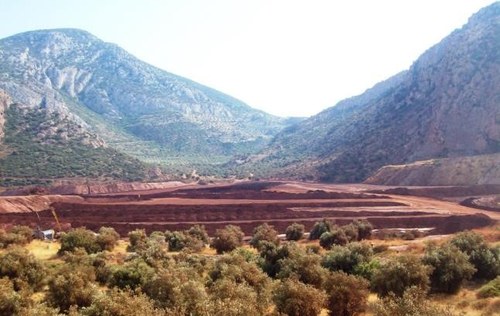Agios Nikolaos plant, 32003, Viotia, Greece

Geological origin of bauxite:
Karstic bauxite ore, mainly coming from the Greek karstic bauxite deposits found in the Mt Helikon – Mt Parnassus – Mt Giona zone, constitutes the major source of the bauxite feed (80%) used for production of metallurgical alumina in the alumina refinery unit of MYTILINEOS “Aluminium of Greece – AoG". Karstic bauxite ore deposits are characterised as diasporic since they contain aluminium oxide primarily in the form of mono-hydrate molecules (diasporic minerals). The rest of the bauxite ore feed needed for alumina production in AoG (20%) consists of imported tropical bauxites, originating from Ghana or Brazil. Tropical bauxite ore deposits are characterised as gibbsitic as they contain primarily tri-hydrated aluminium oxides (gibbsite minerals).
Bauxite processing:
Metallurgical alumina is produced in AoG via the Bayer process, in which sodium hydroxide is utilized to selectively dissolve the aluminium (oxy-) hydroxide minerals of the bauxite ore into a high-concentration sodium hydroxide solution, while leaving unaffected the rest mineral matrix. After leaching, the remaining fraction of the unaffected mineral matrix, is separated by settling, and then washed and filterpressed to produce the bauxite residue by-product, which is stored inland nearby the processing plant.
After-processing bauxite facts and numbers:
MYTILINEOS was among the first alumina refineries to install filterpresses (now BAT) for the dehydration of the inert bauxite residue and its transformation into a drier solid with moisture content of less than 26% that can be safely and easily deposited on land. Since 2011 AoG’s bauxite is filter-pressed in the Filterpress Unit consisting of 4 filterpresses, and is stored as a “dry” by-product in the custom-configured area that the company owns near the plant, in accordance with relevant studies and in compliance with approved environmental terms.
In comparison to wet (mud) storage, bauxite-residue-dry stacking significantly decreases the residual volume of the solid to be deposited, further removes the soda solution and eliminates the risk of spillage and dam failure. Moreover, bauxite residue – being in the form of a dry solid substance, can be utilised in a variety of industrial and other uses, including its use in cement production as a source of iron and aluminium (Al2O3), in rehabilitation of disused mines as a filling material, in brick and rooftile production as an additive raw material, and in cultivating plants as topsoil.
MYTILINEOS AoG alumina refinery produces approximately 750 kt/year of bauxite residue for 830kt/ year alumina. For MYTILINEOS, the re-use of bauxite residue constitutes a focal point, as the company cares to minimize its environmental footprint. Over the last decade, AoG has pioneered in finding, developing, and promoting applications for bauxite residue re-use, and has achieved approximately a 10% annual reuse of bauxite residue in cement plants for OPC production. Since 2018 the company has recycled more than 400,000 t of bauxite residue in four (4) cement plants, located in Greece and Cyprus.
Bauxite residue contains significant amount of raw materials which can be used for an effective re-utilization.
Material contents:
Project Activities:
Preliminary activities - End of 2020 / Start of 2021
May 2021
June 2021
July 2021
Agios Nikolaos plant, 32003, Viotia, Greece